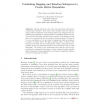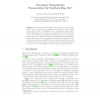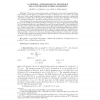240 search results - page 17 / 48 » Forest for the trees |
IDA
2007
Springer
14 years 3 months ago
2007
Springer
Random forests are one of the best performing methods for constructing ensembles. They derive their strength from two aspects: using random subsamples of the training data (as in b...
TON
2010
13 years 4 months ago
2010
Abstract--Energy efficiency is critical for wireless sensor networks. The data-gathering process must be carefully designed to conserve energy and extend network lifetime. For appl...
TAMC
2010
Springer
13 years 8 months ago
2010
Springer
Abstract. Given an undirected graph G and an integer k ≥ 0, the NPhard 2-Layer Planarization problem asks whether G can be transformed into a forest of caterpillar trees by remov...
SODA
1992
ACM
13 years 11 months ago
1992
ACM
We present a general approximation technique for a large class of graph problems. Our technique mostly applies to problems of covering, at minimum cost, the vertices of a graph wit...
ACL
2011
13 years 1 months ago
2011
Tree-to-string translation is syntax-aware and efficient but sensitive to parsing errors. Forestto-string translation approaches mitigate the risk of propagating parser errors in...



